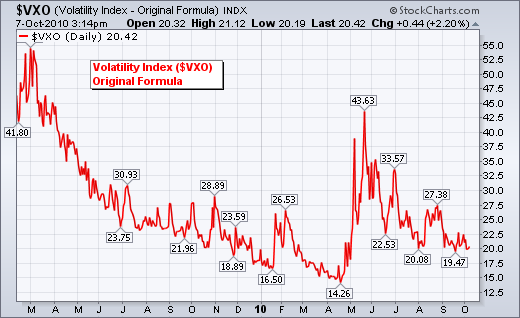In the fast-paced and dynamic world of financial markets, investors often face uncertainty and fluctuations in the value of their investments. Understanding market volatility, or the rate at which prices change over time, is crucial for making informed decisions and managing risk.

Image: school.stockcharts.com
Introducing the Volatility Index: VIX
The Volatility Index (VIX), also known as the “fear gauge,” is a measure of the implied volatility of the S&P 500 index options over the next 30 days. It represents the market’s expectations of potential price fluctuations and investors’ perception of future risk.
The VIX is calculated using a complex formula that considers the prices of S&P 500 index options at various strike prices and expiration dates. A higher VIX indicates a greater level of perceived volatility, while a lower VIX suggests a more stable market environment.
Interpreting the VIX
The VIX is a forward-looking indicator, providing insights into investors’ expectations of future market volatility. It is typically used to gauge market sentiment and risk appetite. A rising VIX indicates increasing investor uncertainty and expectations of greater price swings, while a falling VIX suggests a more confident market and lower anticipated volatility.
As a market risk measure, the VIX is closely monitored by investors, financial institutions, and policymakers. High levels of volatility can lead to increased investment uncertainty, lower investor confidence, and potentially severe market corrections. Conversely, low levels of volatility encourage risk-taking, investment, and economic growth. Consequently, the VIX plays a crucial role in shaping investment strategies and managing financial portfolios.
Recent Trends and Developments
The VIX has been in focus in recent years due to heightened market volatility and geopolitical uncertainties. The COVID-19 pandemic, trade conflicts, and ongoing geopolitical tensions have all contributed to increased market volatility, driving the VIX higher.
Market participants are closely watching the VIX for signs of extreme volatility and potential market turning points. A sustained high VIX can indicate a potential market crash, while a sustained low VIX may signal a prolonged period of low volatility and complacency.

Image: www.whitewavetradingstrategies.com
Tips and Expert Advice
Understanding the VIX can help investors make more informed investment decisions and manage their financial risk effectively. Here are some tips and expert advice:
- Monitor the VIX regularly: Regular tracking of the VIX can provide valuable insights into market sentiment and potential volatility levels.
- Consider the VIX when making investment decisions: A high VIX may indicate a riskier market and warrant caution, while a low VIX may provide an opportunity to increase risk exposure.
- Use the VIX to manage risk: Investors can use the VIX to hedge against potential market downturns by investing in inverse volatility products or adjusting their portfolio allocation accordingly.
- Avoid overreacting to short-term VIX movements: While the VIX is a useful tool, it should not be used for day-to-day trading decisions. Rather, it should be viewed as a long-term risk indicator.
FAQs on the Volatility Index
Q: What is the optimal level of the VIX?
A: There is no optimal level of the VIX as it varies depending on market conditions. However, a VIX below 15 is generally considered indicative of a low-volatility environment, while a VIX above 25 indicates a more volatile market.
Q: Can the VIX predict market crashes?
A: While the VIX is not a perfect predictor of market crashes, it can provide some indication of market sentiment and potential risks. A sustained high VIX may signal an increased likelihood of a major market correction.
What Is A Volatility Index
Conclusion
The Volatility Index (VIX) is a valuable tool for investors seeking to understand market volatility, gauge investor sentiment, and manage financial risk. By closely monitoring the VIX and considering the tips and expert advice provided, investors can make more informed investment decisions and navigate market fluctuations more effectively.
Understanding the VIX is not just for professional traders and financial analysts; it empowers individual investors with the knowledge they need to participate confidently in the financial markets. Whether you are a seasoned investor or just starting your financial journey, understanding the VIX and its implications can help you make more informed decisions and achieve your investment goals.







